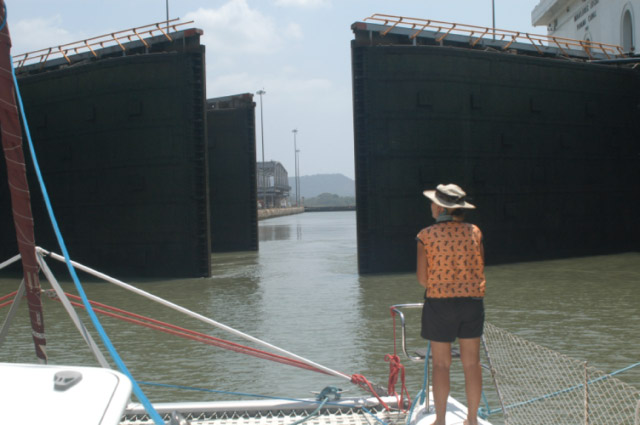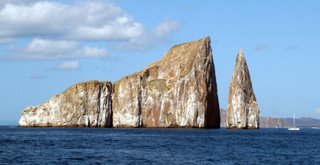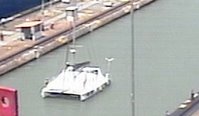
Finally, the day came. We were scheduled to start our transit at 4pm Wednesday February 28th. All five of our crew were aboard and on Tuesday we received our four 125’ long lines and 12 tire fenders from our agent, Stanley.
On Wednesday morning we motored out of Shelter Bay Marina and anchored in the flats. We dinghied into the Panama Canal Yacht Club to buy fuel, and to receive our clearance papers from Stanley.
At 4pm precisely we raised anchor and trolled about waiting for our Transit Advisor, Felipe. He arrived at 5pm and the ACP (Panama Canal Authority) Pilot Boat managed to hit us and bend a stanchion – so the Transit did not start well!
Unusually, we went through alone. Most small boats are rafted with others to take up less space but presumably there were no other boats that night. It meant that we would use all four of our lines so each line handler would have their own. When rafted, line handlers can work in pairs.
Felipe checked all the lines and gave specific instructions to each line handler. This worked well because it was a new experience for all of them.
We entered the first chamber of Gatun Locks behind a large freighter. Men on the lock walls threw four ‘messenger lines’ and the line handlers (Ginger, Mike, Jan and Nick) tied them onto our long dock lines. One messenger line fell into the water, but Filipe quickly recovered the situation. Once in the chamber, I stopped the boat and the ACP men pulled our lines up and put them on bollards. The line handlers tied them off and we waited for the water.
The lock water literally boils up from the bottom of the lock pushing the boat about. As long as the line handlers kept their lines under control we stayed safely away from the lock walls. When the water settled at its new level, and the freighter ahead started moving, at a signal from Filipe our lines came off the bollards and we pulled them back aboard. The messenger stayed attached and the ACP men walked alongside as I motored into the next chamber.
This process was repeated three times in each of the three chambers of Gatun Locks. Eventually we exited the last chamber into Gatun Lake and motored a mile or so to our mooring spot. There we tied up, said goodbye to Filipe and had dinner. It was about 8:30pm.
Thursday March 1st our next Advisor Rodolpho arrived at 6:30am and we set off across Gatun Lake and into the Canal proper. It’s about 25 miles from Gatun Locks to Pedro Miguel Lock and we motored at 7 knots to make our scheduled Lock time of 11am.
‘Locking Down’ was similar to ‘Locking Up’ except that the water was much more sedate so there seemed to be less chance of an accident.
From Pedro Miguel Lock to Miraflores Lock is about a mile and we called relatives as we approached for them to watch us on the webcam – several reportedly did.
Miraflores Lock has two chambers and at about 1pm the final gates opened and we motored into the Pacific. As we passed under the Bridge of the Americas, we cracked a bottle of champagne and said goodbye to Rodolpho.
We dropped off our long dock lines and tire fenders into the Balboa Yacht Club launch and continued on to anchor near Isla Flamenco. At this point, everyone was physically and mentally exhausted so we just slept.
So we’re in the Pacific. Happily, we’ll never have to through that experience again; it’s exciting and scary in equal measure.
 We arrived in Puerto Ayora, Isla Santa Cruz on the morning of Sunday March 18th.
We arrived in Puerto Ayora, Isla Santa Cruz on the morning of Sunday March 18th. I have just posted PodCastaway Show #14 which is a 'soundseeing' record of our Panama Canal transit. It can be downloaded, or subscribed to, from my podcast page.
I have just posted PodCastaway Show #14 which is a 'soundseeing' record of our Panama Canal transit. It can be downloaded, or subscribed to, from my podcast page.
 Finally, the day came. We were scheduled to start our transit at 4pm Wednesday February 28th. All five of our crew were aboard and on Tuesday we received our four 125’ long lines and 12 tire fenders from our agent, Stanley.
Finally, the day came. We were scheduled to start our transit at 4pm Wednesday February 28th. All five of our crew were aboard and on Tuesday we received our four 125’ long lines and 12 tire fenders from our agent, Stanley.